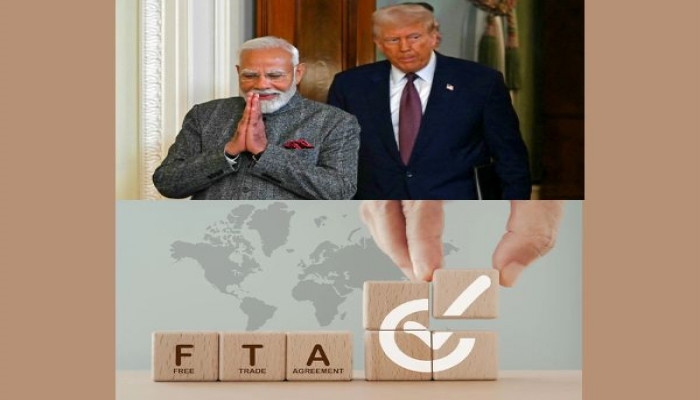India ramps up trade talks with EU, Latin America to offset impact of US tariffs
- In Reports
- 08:35 PM, Aug 01, 2025
- Myind Staff
India began expanding exports to the European Union, Peru, and Chile in a bid to reduce the pressure on labour-intensive sectors after US President Donald Trump imposed a 25 per cent tariff on Indian goods. According to a source, India was planning to fast-track negotiations for free trade agreements with these regions.
“We are betting on speeding up talks with the EU, Peru and Chile, because some of our exports can be absorbed by these nations,” the source was quoted as saying.
Soon after the tariff hike was announced by Trump, officials from India’s commerce ministry held a conference call on July 31 with exporters from the leather and textile sectors, which together account for over 10 billion dollars in annual exports to the US.
These sectors now faced a minimum tariff of 25 per cent, up from the earlier 10 per cent.
While India continued to monitor the situation, it also took steps to diversify its exports to Latin America and Europe and accelerated its push for preferential trade access.
Discussions were underway with the EU and Peru, and India aimed to expand a Preferential Trade Agreement with Chile that had originally been signed in 2006.
The US accounts for roughly 16 to 17 percent of India’s total exports. Of this, close to 10 per cent could potentially be redirected to markets in Latin America and Europe to avoid the higher US duties.
“Sectors most affected by Trump's recent tariff action, such as marine products, textiles and gems and jewellery, are turning to diversify to these markets,” the source further said.
India exported ready-made garments, jewellery, and marine products worth nearly 18 billion dollars to the US during the 2025 fiscal year. Total exports to the US that year stood at 86.51 billion dollars.
A drop of around 3 to 4 per cent in exports to the US was expected due to the 25 per cent tariffs, the source said, not including any indirect penalties related to India’s ties with Russia. “A 3‑4 per cent dip in Indian exports to the US was anticipated on account of 25 per cent tariffs on India, not considering the unstated penalty due to India's Russian alignment,” said the source.
A quicker deal with Peru and Chile could also help Indian exporters of steel and aluminium, who were now facing close to 50 per cent tariffs in the US.
"IT may also enable India to divert some of our engineering exports, some of which are dependent on steel and aluminium, through these Latin American nations. In doing so, we would possibly avoid the higher US tariffs and access more favourable terms of trade," the source said.
Engineering goods were India’s top export to the US, totalling around 20 billion dollars in the 2024-25 fiscal year.
The US had imposed the new 25 per cent tariffs on July 30, shortly before India and the US were scheduled to conclude a Bilateral Trade Agreement later in the year. The move came after a proposed mini-deal between the two sides fell through just before the August 1 deadline for the new tariffs.
Progress on EU, Peru, and Chile Trade Talks
India and the EU concluded the twelfth round of talks in Brussels from July 7 to 11, 2025, reaching a preliminary agreement on the Digital Trade chapter and an Anti-Fraud clause, subject to further technical review.
Both sides hoped to wrap up negotiations by the end of the year. “Now that the US-EU agreement is finalised, attention can be turned to India,” a second source added.
Under the finalised US-EU pact, American goods received zero-tariff access to EU markets, while EU products faced a 15 per cent tariff entering the US.
The EU remained India’s top trading partner, with exports reaching 98.34 billion dollars in fiscal year 2025. A second round of negotiations with the EU was planned for September, alongside continued virtual meetings.
India also held eight rounds of physical meetings with Peru and began formal discussions with Chile in May to expand its trade agreement.
“Engineered goods, machinery, textiles, gems and jewellery, marine products, leather were some of the items that could be diverted to these Latin American countries and the EU,” the source added.
India’s exports to Latin America totalled 15.17 billion dollars in fiscal year 2025.
Some strategic items, like auto components, were still making their way to the US despite higher tariffs due to limited diversion options, the source said.
Stalled Trade Talks with the US
India continued to engage in trade negotiations with the US, seeking clarity on both the 25 per cent tariffs and the informal penalties.
“India wanted to remain silent until it got clarity on the nature of the tariffs and penalties and their impact on Indian exports,” said the source.
Talks had stalled over Washington’s demands for greater access to Indian markets in agriculture, dairy, and genetically modified products. No agreement had been reached on these issues since discussions began in March and continued through July.
A US delegation was expected in New Delhi for another round of negotiations in mid-August. Until now, five rounds had been completed.
Speaking at a Parliament briefing on July 31, Commerce Minister Piyush Goyal said the ministry was examining the tariff impact and collecting industry feedback. He said the government was committed to protecting the interests of farmers, MSMEs, and workers.
Indian officials had proposed tariffs between 10 and 16 percent on Indian goods in exchange for duty-free access for most US industrial products. However, US demands for broad concessions in sensitive areas led to a breakdown in talks. India had agreed to narrow concessions on apples and duty cuts on nuts.
India was also in advanced discussions for a trade deal with Oman and exporters were urging a pact with Mexico.
A recent trade agreement with the United Kingdom was expected to take up to a year to come into force. The deal with EFTA countries, Iceland, Liechtenstein, Norway and Switzerland, was likely to be implemented from October.







Comments